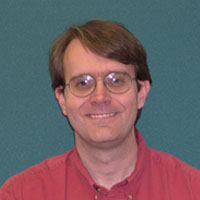
Theoretical Nuclear Astrophysics
Office: 310A South College
Phone: 865-974-5913
raph@utk.edu
- PhD, Astronomy, Harvard University (1995)
- AM, Astronomy, Harvard University (1991)
- BS, Physics and Astronomy; and BS, Math: University of Maryland at College Park (1989)
- Joint Faculty Member, UT Department of Physics and Astronomy (2010-present)
- Computational Astrophysicist, Physics Division, Oak Ridge National Laboratory (2004-present)
Group Leader for Theoretical Physics, Physics Division, Oak Ridge National Laboratory (2012-present) - Post-doctoral Research Associate/Research Assistant Professor, UT/ORNL Theoretical Astrophysics Group (1997-2004)
- Post-doctoral Research Associate in Astronomy, University of Texas at Austin (1995-1997)
- Fellow, American Physical Society (2023)
- Sigma Xi Young Investigator Award (2006)
- Nuclear Astrophysics
- Stellar Evolution
- Stellar Explosions
- Learning about nucleosynthesis from multi-dimensional simulations of core-collapse supernovae. W. Raphael Hix, J. Austin Harris, Eric J. Lentz, Stephen Bruenn, O. E. Bronson Messer, and Anthony Mezzacappa. Conference Paper, Nuclei in the Cosmos XV, pp 115-120 (2019). (https://link.springer.com/book/10.1007/978-3-030-13876-9).
- Nuclear reactions in the crusts of accreting neutron stars. R. Lau, M. Beard, S.S. Gupta, H. Schatz, A.V. Afanasjev, E.F. Brown, A. Deibel, L.R. Gasques, G.W. Hitt, W.R. Hix, et al. The Astrophysical Journal, 859, 1 (2018). (https://iopscience.iop.org/article/10.3847/1538-4357/aabfe0)
- Multi-dimensional simulations of core-collapse supernova explosions with CHIMERA. O. E. B. Messer, J. A. Harris, W. R. Hix, E. J. Lentz, S. W. Bruenn, and A. Mezzacappa. AIP Conference Proceedings 1947, 020017 (2018) (https://doi.org/10.1063/1.5030821)
- The ν process in the innermost supernova ejecta. Andre Sieverding, Gabriel Martínez Pinedo, Karlheinz Langanke, J. Austin Harris, and W. Raphael Hix. Nuclear Physics in Astrophysics VIII (NPA8 2017), EPJ Web of Conferences 165, 01045 (2017). (https://doi.org/10.1051/epjconf/201716501045).
- Hydrodynamic simulations of cassical novae: accretion onto CO white dwarfs as SN Ia progenitors. S. Starrfield, M. Bose, C. Iliadis, W.R. Hix, R.M. Wagner, C.E. Woodward, J. Jose, and M. Hernanz. Proceedings of Science 315 - The Golden Age of Cataclysmic Variables and Related Objects IV (2017). (https://pos.sissa.it/315/066/pdf)
- Implications for post-processing nucleosynthesis of core-collapse supernova models with Lagrangian particles. Harris, J. Austin; Hix, W. Raphael; Chertkow, Merek A.; et al. Astrophysical Journal 843 1 (2017). (https://iopscience.iop.org/article/10.3847/1538-4357/aa76de)
- The thermonuclear runaway and the classical nova outburst. Starrfield, S.; Iliadis, C.; Hix, W. R. Publications Of The Astronomical Society Of The Pacific 128 963 (2016). (https://iopscience.iop.org/article/10.1088/1538-3873/128/963/051001/meta)
- The development of explosions in axisymmetric ab initio core-collapse supernova simulations of 12-25 stars. Bruenn, Stephen W., Lentz, Eric J., Hix, W. Raphael, et al. Astrophysical Journal 818 2 (2016). (https://iopscience.iop.org/article/10.3847/0004-637X/818/2/123)
- Axisymmetric ab initio core-collapse supernova simulations of 12-25 stars. Bruenn, Stephen W.; Mezzacappa, Anthony; Hix, W. Raphael; et al. Astrophysical Journal Letters 767 1 (2013). (https://iopscience.iop.org/article/10.1088/2041-8205/767/1/L6)
- Neutrino-induced nucleosynthesis of a > 64 nuclei: The nu p process. Frohlich, C; Martinez-Pinedo, G; Liebendorfer, M; et al. Physical Review Letters 96 14. (2006) (https://www.ncbi.nlm.nih.gov/pubmed/16712066)
- Composition of the innermost core-collapse supernova ejecta. Frohlich, C; Hauser, P; Liebendorfer, M; et al. Astrophysical Journal 637 1 (2006). (https://aip.scitation.org/doi/10.1063/1.2234421)
- Consequences of nuclear electron capture in core collapse supernovae. Hix, WR; Messer, OEB; Mezzacappa, A; et al. Physical Review Letters 91 20 (2003). (https://journals.aps.org/prl/pdf/10.1103/PhysRevLett.91.201102)
- Electron capture rates on nuclei and implications for stellar core collapse. Langanke, K; Martinez-Pinedo, G; Sampaio, JM; et al. Physical Review Letters 90 24 (2003). (https://journals.aps.org/prl/pdf/10.1103/PhysRevLett.90.241102)
- Probing the gravitational well: No supernova explosion in spherical symmetry with general relativistic Boltzmann neutrino transport. Liebendorfer, M; Mezzacappa, A; Thielemann, FK; et al. Physical Review D 63 10 (2001). (https://journals.aps.org/prd/abstract/10.1103/PhysRevD.63.103004)
- Simulation of the spherically symmetric stellar core collapse, bounce, and postbounce evolution of a star of 13 solar masses with Boltzmann neutrino transport, and its implications for the supernova mechanism. Mezzacappa, A; Liebendorfer, M; Messer, OEB; et al. Physical Review Letters 86 10 (2001). (https://journals.aps.org/prl/abstract/10.1103/PhysRevLett.86.1935)
- The role of electron captures in Chandrasekhar-mass models for Type Ia supernovae. Brachwitz, F; Dean, DJ; Hix, WR; et al. Astrophysical Journal 536 2 (2000). (https://iopscience.iop.org/article/10.1086/308968)
- Nucleosynthesis in Chandrasekhar mass models for type IA supernovae and constraints on progenitor systems and burning-front propagation. Iwamoto, K; Brachwitz, F; Nomoto, K; et al. Astrophysical Journal Supplement Series 125 2 (1999). (https://iopscience.iop.org/article/10.1086/313278)
- Inside the supernova - a powerful convective engine. Herant, M; Benz, W; Hix, Wr; et al. Astrophysical Journal 435 1 (1994). (https://arxiv.org/abs/astro-ph/9404024)